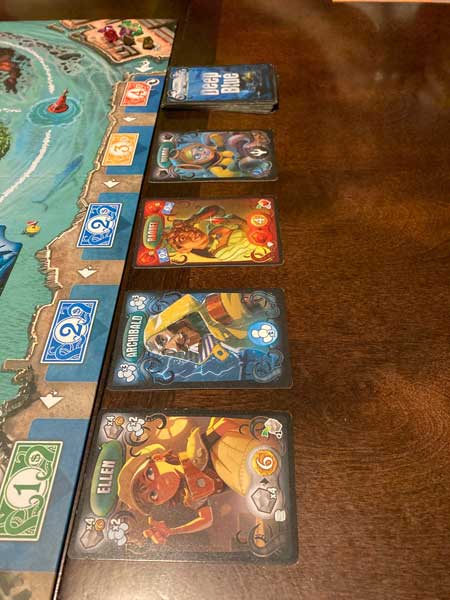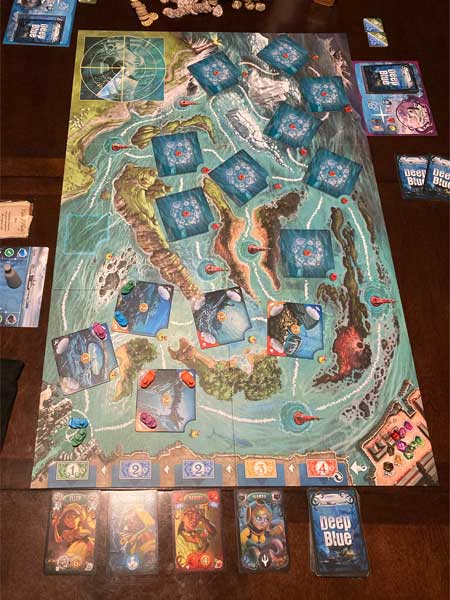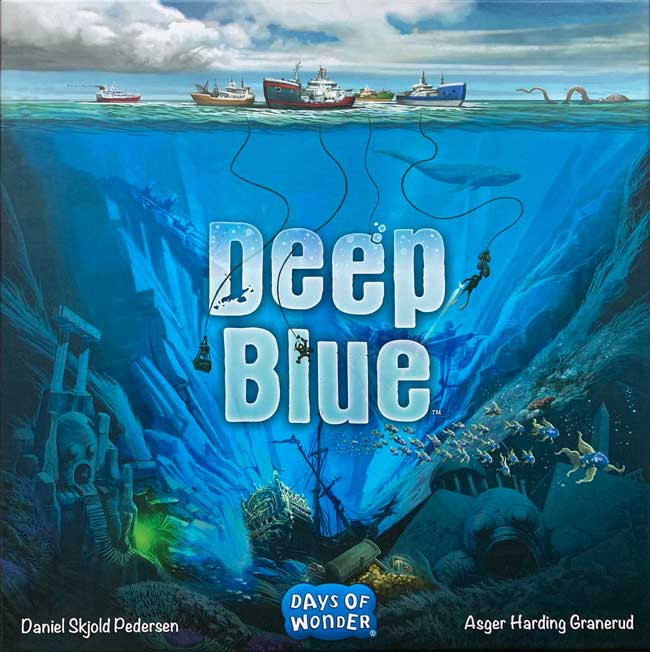Deep Blue is a game published by Days of Wonder. The premise of the game is for players to take on the role of treasure hunters who lead and participate in dives to acquire treasure worth victory points. The game ends immediately when the fourth Sunken City Tile has been dived and is placed in the lower left corner of the board. The player with the most victory points is declared the winner.
This post is broken into the following 3 sections, feel free to jump directly to one:
- General summary - consisting of information about overall enjoyment, theme, replayability, and upgrades
- Complexity - consisting of information about the rulebook, setup, player turns, and overall learning curve
- Player turns - consisting of game type, game flow, rule you are likely to miss, and favorite aspect
General Summary
Number of players we had: 4
Our play time (not including setup): 1 hour 10 minutes
Overall enjoyment

Overall our group enjoys playing this game for several reasons. Deep Dive is an easy to learn game with a strong press-your-luck mechanism. At the beginning of the game, players focus on building the best possible deck for themselves so they last longer in dives and gain the most possible victory points. Dives can be very short, or last a long time depending upon how far players want to press their luck and how lucky they are drawing gems.
This game has a cute underwater theme and is great for any player group. Additionally, this would be a great game to introduce to someone new to gaming, though it has more meat to it than a starter game. While pulling gems during dives is all luck-based, how you build up your player deck has a great deal to do with how long you can stay in a dive.
When adding crew members, players need to remember to keep a balance of those cards that protect against hazards, in addition to recruiting crew members that provide victory points for specific gems and total number of gems. Additionally, cards played from your hand often earn more victory points during dives than the points awarded by the gems themselves.
If we had to pick one thing that frustrated us with this game it is that if you aren't careful joining other players' dives, you will find it challenging to have the cards you want to lead your own best dive. In other words, if you take too many turns resting, inevitably, some other player on the same wreck tile as you will lead the dive before you can. While it can be frustrating to have someone else beat you to a dive, it is another aspect of the game where players must choose between pressing their luck in drawing up the best hand before a dive, or choosing to dive with the cards they have before someone else beats them to it. This keeps the game more interesting and all players engaged at all times.
Theme

The theme of this game is underwater treasure hunting and is carried out across all game elements really well. The game board is mostly sea with some land and obstacles. The player boards, wreck tiles, cards, dive site board, diving bell pawn, boats, gems, treasure chests, victory point tokens and crew member cards all add to the theme in an immersive way that is both fun and appropriate for any player group.
Also, it is worth nothing the game has a great plastic insert that keeps all pieces in place, including all the victory point tokens!
Replayability

Both the starting and advanced wreck tiles are randomized on the board, but all of them are used each game. The biggest thing increasing the replayability of this game are the captain's log scenarios. Each game one of seven captain's log scenarios are added to the game which changes some form of the game play. For example, not allowing players to rush to a dive from other tiles or forcing the leader of a dive to pull two gems on each draw instead of one. The other main thing that changes the game is the people you play with as the press-your-luck element of dives is approached very differently by each player.
Upgrades
As far as I know there are no available upgrades for this game.
Complexity
Rule book
The rule book is well organized and easy to follow. There are lots of images describing how to play the game and symbols are enlarged so players can more easily understand what they mean and how they work. Additionally, the background around the rules on each page has an underwater scene including a wrecked ship, and while it does not add to the game specifically, it is a nice touch and goes well with the theme.
Setup
Setting up Deep Dive is quick and only takes about 5 minutes. Both sets of wreck tiles are randomized and placed on their locations on the game board. The gems are separated based on the numbers in the upper right corner of the board and the remainder are placed in the gem bag. A random captain's log scenario is chosen and the crew member cards are shuffled and four are revealed to the right of the board by their respective recruiting cost.

Once players choose a color and take their two boats, player board, starting crew cards, a treasure chest and the appropriate number of starting tokens, you are ready to begin.
Turns
On their turns players pick from the following four actions:
- Recruit a crew member - discard cards worth the value of the crew member to recruit and place that crew member into your hand.
- Sail - discard cards with movement values and move your boat or boats the total number of movements.
- Rest - shuffle all discarded cards on your player board and draw three new cards into your hand.
- Dive - Lead a dive on a tile one of your boats occupies.
Overall learning curve
The overall learning curve of this game is low. There are only four actions each player can take on their turn and they are pretty simple actions. Also, because players can participate in other player's dives, players are able to learn the game play and pick a strategy more quickly.
Player Turns
Play type
Deep Blue is a symmetrical game with a strong press-your-luck mechanism in addition to elements of hand management and deck and pool building. Players must add crew members who will protect them from hazards during dives, as well as crew members who will win them victory points when certain gems are pulled. Players must also balance the possible benefits of joining a dive led by another player with keeping the cards in their hand to lead their own dive.
When leading a dive, players control how many gems are pulled from the bag, basing this on the resource and protection cards they have in their current hand of cards. At times it can be better to end a dive early if you do not have the potential to gain more victory points, but other players do, based on the crew member cards recruited/in their hands.
Game flow
Other than dives, turns go very quickly. Recruiting a new crew member, sailing, and resting all take less than a minute. Additionally, when players lead a dive, all other players have the possibility of partaking in the dive if they have a boat on the tile, or are on a neighboring tile, and choose to rush to the dive tile.

Dives almost always involve multiple players so players are paying attention even though this action takes longer than all others. Also, during dives, players can earn points in two ways: by playing cards that match the type, number, or both, of the gems pulled from the bag, AND points for those gems pulled that provide victory points by remaining in the dive until it is finished. When a player is not able to participate in a dive to the very end, they do not get points for the gems pulled, but they do collect victory points earned for cards played during the dive.
Rule you are likely to forget/miss
The one rule you are likely to forget or miss is to add gems to the gem bag from the group that is set aside at the top corner of the board during setup whenever a new crew member card with that gem on it is revealed.
Favorite aspect
Our favorite aspect of this game is how all players on the current dive tile automatically participate in the dive in addition to the fact that players that have a boat within one movement away can rush in and take part in the dive. We also really like that players can gain victory points in each dive in two ways, and even if they cannot last the entire dive, they are still able to keep the points they earned by playing cards. This makes the game more interactive and rewarding for all players.
Deep Dive is a fun game that can be setup quickly, taught to new players in about 15-20 minutes, has a great insert for organizing all items when finished, and has some nice deck building and press-your-luck elements. This is a great game to introduce new players to as it has some meat to it, has several actions to choose from without being overly complex, and is an engaging game.


